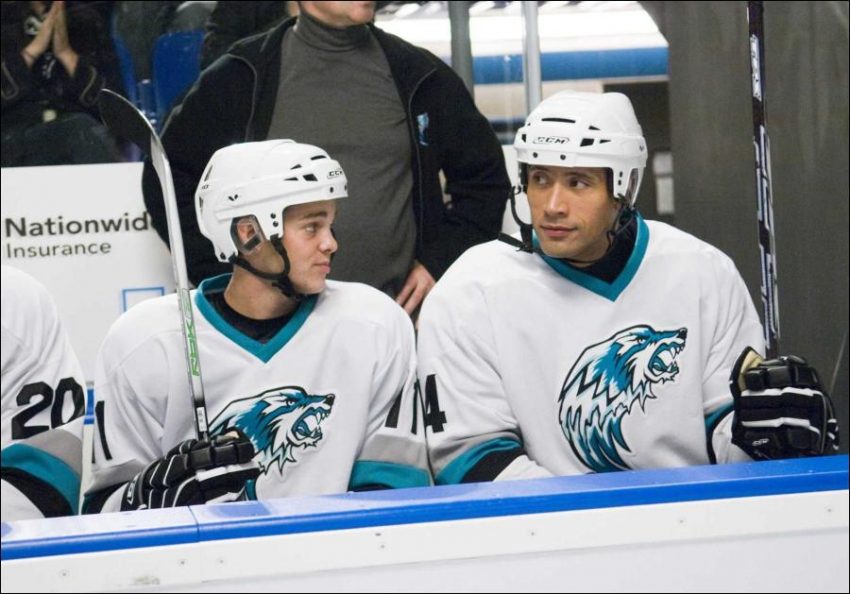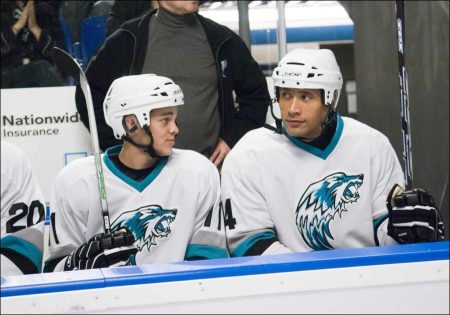Taglines: The tooth hurts.
Derek Thompson is a hard-charging hockey player whose nickname comes from his habit of separating opposing players from their bicuspids. When Derek discourages a youngster’s dreams, he’s sentenced to one week’s hard labor as a real tooth fairy, complete with the requisite tutu, wings and magic wand.
At first, Derek “can’t handle the tooth” – bumbling and stumbling as he tries to furtively wing his way through strangers’ homes…doing what tooth fairies do. But as Derek slowly adapts to his new position, he begins to rediscover his own forgotten dreams.
Dwayne Johnson is the TOOTH FAIRY, also known as Derek Thompson, a hard-charging hockey player whose nickname comes from his habit of separating opposing players from their bicuspids. When Derek discourages a youngster’s dreams, he’s sentenced to one week’s hard labor as a real tooth fairy, complete with the requisite wings and magic wand. At first, Derek “can’t handle the tooth” – bumbling and stumbling as he tries to furtively wing his way through strangers’ homes… doing what tooth fairies do. But as Derek slowly adapts to his new position, he begins to rediscover his own forgotten dreams.
One of today’s most popular actors, Dwayne Johnson’s juxtaposition of sharp comedic timing and impressive physicality has delighted audiences in pictures like “The Game Plan,” “Get Smart” and “Race to Witch Mountain.” His latest effort, TOOTH FAIRY, brings together several elements he thought would be fun to explore. “It’s a story with universal appeal,” says Johnson. “It’s a fish-out-of-water tale about believing in the impossible and the magic. It’s for families and everyone.
“The Tooth Fairy is part of our culture,” he continues, “and part of the wonderment of being a child. It’s a character that’s never been explored, to this extent, in the movies.”
To most of the world, the Tooth Fairy is a magical figure. Like Santa Claus and the Easter Bunny, the Tooth Fairy is both an inspiring and comforting character who teaches children to use their imaginations – and to dream. And while there are no definitive renderings, most of us envision the Tooth Fairy as a gentle sprite who magically appears during a child’s slumbers to take his or her newly-displaced tooth from under the pillow and replace it with money.
It’s a safe bet that no one has imagined the Tooth Fairy to be a hockey player/ “enforcer” – until Derek Thompson, beloved by his fans for his hyper-aggressive play on the ice, becomes the newest addition to ranks of Tooth Fairydom.
Derek had been a major league hockey star, but after suffering an injury, he never found his way back to ruling the rink. Instead, he settled for being a hockey tough guy – a bruiser who takes out opposing players as his fans chant “The tooth hurts!” and “You can’t handle the tooth!” “Derek still aspires to be great,” says Dwayne Johnson, “but he’s lost his way and isn’t sure how to come back and recapture his dreams.”
Derek is a good guy at heart, but his own lowered expectations have caught up with him. When one young autograph-seeker asks Derek if it’s possible for the youngster to achieve hockey stardom, Derek discourages the boy’s hopes. “Derek is not saying those things to hurt the kid,” says Johnson. “In Derek’s mind, it’s a very sensible approach and good advice. He has yet to learn the bigger, more valuable lesson of the importance of dreams.”
After his dream-killing faux pas, Derek awakens one night to find – under his pillow, no less – a summons accusing him of Violation 70136: “Dissemination of Disbelief.” Before Derek figures out what that even means, he suddenly sprouts wings and is sucked up into a vortex that deposits his now tutu-clad frame in a pastel alternate universe known as Fairyland – a magical version of a massive train station, which is about to become Derek’s new training ground.
The pink tutu is a wardrobe malfunction (“but I really wanted it in the film,” Johnson admits) – Derek eventually sports more masculine-looking Tooth Fairy duds – but his summons is no mistake. He has a lot to answer for, as a “Dream Killer guilty of first degree dasher of fantasy.”
Derek’s chief accuser is Fairyland’s no-nonsense matriarch, Lily (Julie Andrews), who sentences Derek to two weeks of hard time as a Tooth Fairy. And who better to take on the role of the stern but ultimately warm-heated Chief Tooth Fairy, than family film icon Julie Andrews, who has delighted audiences for over 40 years – from her roles in “Mary Poppins” and “The Sound of Music” to her more recent work in “The Princess Diaries.”
Andrews found much to appreciate in TOOTH FAIRY’s message. “The thing that really sold me on doing TOOTH FAIRY was its message that children must be allowed to dream and fantasize and use their imagination,” she points out. “I think what makes a good family film is a quality of joy and perhaps a certain innocence”
Andrews was a major casting coup. “We were so thrilled that Julie agreed to join the team,” says producer Jason Blum. “There is no better person to play this role.” Blum credits TOOTH FAIRY director Michael Lembeck, a former actor, with playing a key role in bringing Andrews aboard. “[Julie’s casting] was largely thanks to Michael, who was an actor for a long time and is great with making actors feel comfortable and safe. With comedy you really need that safety net.”
While it’s Julie Andrews’ Lily who lays down the Fairydom law for the increasingly bewildered Derek, she leaves it to an administrative fairy, Tracy, to make sure Derek fulfills his sentence. It’s far from a magical alliance: Derek and Tracy get off on the wrong foot and things quickly go downhill from there. Taking on the role of the put-upon caseworker is comic actor Stephen Merchant, who achieved international renown for his collaborations with Ricky Gervais on the U.K. series “The Office” (upon which the NBC series is based) and “Extras.” “Derek and Tracy are at loggerheads throughout the story,” says Merchant. “Derek resents being sentenced, and Tracy’s bureaucratic officiousness irks him even more.” Compounding the issue is Tracy’s obvious case of “wing envy.” “Tracy aspires to be a real Tooth Fairy because that’s where the glamour is,” Merchant explains. “He resents that Derek’s been given this plum assignment [as a winged Tooth Fairy],” though Derek doesn’t see it that way.
The pairing of Johnson and Merchant provides many moments of physical comedy, some of which stem from their contrasting physiques: Merchant is very tall and thin, while Johnson possesses what Merchant calls a “superhuman” body.
As Derek’s caseworker, Tracy must make sure the newly-minted Tooth Fairy has the requisite tools he’ll need to fulfill his sentence. To that end, one of their first stops in Fairyland is the basement warehouse of Jerry, who outfits Derek with the tricks-of-the-tooth fairy trade. The gadgets and gizmos include:
1. Wand with All-Purpose Magic Generator Button (if Derek could figure out how to use it)
2. Invisibility Spray (a T.F. essential)
3. Shrinking Paste (great for enabling Derek to slide under doorways – but not without its own hazards)
4. Dog Bark Mints (great for practical jokes)
5. “Cat-Away” (our feline friends can be tough adversaries for a shrunken tooth fairy (see #3)
6. Amnesia Dust (we can’t have people remembering they saw an actual tooth fairy) Derek’s assignment is complicated by – and ultimately enabled by – his very human relationship with girlfriend Carly (Ashley Judd) and her two children, Tess, age 5, and Randy,
14. “Both kids are at an age where dreaming and setting goals are vital,” says Johnson. “Derek doesn’t quite get that, until he sees their dreams are being shaken – by him.”
Their mom, Carly, provides a steadiness and grounding to Derek as he undertakes his strange journey as a Tooth Fairy. Carly is unaware of Derek’s new secret life, which makes her, says Ashley Judd, the film’s “straight man.”
“But I knew acting in TOOTH FAIRY would be a wonderful opportunity to express these wonderful themes about holding on to your dreams,” she adds. “Derek is basically an overgrown child, and Carly and her kids help him find his childlike spirit.”
According to director Michael Lembeck, the Dwayne Johnson-Ashley Judd pairing is unexpected, facilitating a Derek-Carly dynamic that is clearly a case of opposites attracting one another. “Derek and Carly are like the cowboy and the showgirl, you know, or the longshoreman and the debutante,” Lembeck explains. “Only in our film, it’s the tough hockey guy and the really articulate, wonderful, sophisticated mom. They’re so different that it makes their relationship really special.”
But even as Derek discovers new ways to relate to Carly, Randy and Tess, his journey is fraught with a series of indignities. As he learns the Tooth Fairy ways, he’s stepped on (see “Shrinking Paste,” above), flushed down a toilet, bitten and arrested. He also faces a challenge on the rink from a young hockey star (played by skateboarding phenomenon Ryan Sheckler). But as hockey’s “Tooth Fairy” slowly adapts to his new role as the real-deal, he finally makes the most unexpected discovery of all: his own dreams. And that is the tooth, the whole tooth, and nothing but the tooth.
Filming TOOTH FAIRY was in some ways like making three different movies. Production began with the story’s high-octane hockey sequences. Producers Mark Ciardi and Gordon Gray, through their company Mayhem Pictures, have considerable experience in bringing to life sports action on screen, having produced “The Rookie,” “Miracle,” “Invincible” and “The Game Plan,” the latter starring Dwayne Johnson as a football player. “For TOOTH FAIRY, we felt it was very important to make a portion of Derek’s life really masculine and sports-oriented, and from this came the idea of making him a hockey player,” recalls Ciardi. “We brought in ‘Coach’ Mark Ellis as our hockey stunt coordinator, to bring authenticity to the hockey sequences.”
To director Michael Lembeck, a longtime hockey fan, filming the hockey sequences was one of the highlights of the shoot. “I was determined not to capture what we’ve seen in hockey movies before, but really get on the ice and feel the grace, skill, speed, pace and visceral quality of hockey,” he says. “It’s been a thrill for me to come in with a particular vision and work with ‘Coach’ Mark Ellis to choreograph the plays. Our skaters were fantastic – ranging from kids who skated first line on their college teams, to several guys who played professionally. It was breathtaking to be on the ice with the cameras down low and feel the sheer power of what these guys do.”
“Part two” of the shoot focused on the characters of Derek, Carly, and youngsters Tess and Randy. These scenes grounded the film in the reality of the characters’ day-today lives. For “part three” of the shoot, cast and crew moved to Mammoth Studios, Vancouver’s largest sound stages, to take up residence in “Fairyland.” Production designer Marcia Hinds modeled the bustling hive of activity, where fairies come and go on tooth-collecting assignments around the globe, on an enormous train station. “The idea is that there are no doors, allowing the fairies to move through this open-ended structure that floats in the sky,” she explains.
Tooth Fairy (2010)
Directed by: Michael Lembeck
Starring: Dwayne Johnson, Ashley Judd, Julie Andrews, Chase Ellison, Billy Crystal, Ellie Harvie, Brandon T. Jackson, Josh Emerson, Barclay Hope, Michael Daingerfield, Destiny Whitlock
Screenplay by: Lowell Ganz, Babaloo Mandel, Joshua Sternin
Production Design by: Marcia Hinds
Cinematography by: David Tattersall
Film Editing by: David Finfer
Costume Design by: Angus Strathie
Set Decoration by: Mary-Lou Storey
Art Direction by: Michael N. Wong
Music by: George S. Clinton
MPAA Rating: PG for mild language, some rude humor and sports action.
Distributed by: 20th Century Fox
Release Date: January 22, 2010



